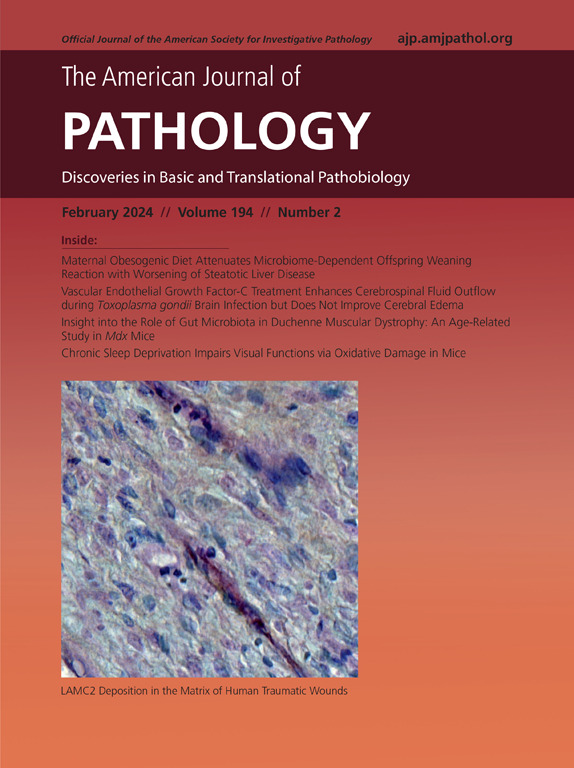Zinc Finger Protein Znf296 Is a Cardiac-Specific Splicing Regulator Required for Cardiomyocyte Formation
IF 3.6
2区 医学
Q1 PATHOLOGY
引用次数: 0
Abstract
Heart formation and function are tightly regulated at transcriptional and post-transcriptional levels. The dysfunction of cardiac cell–specific regulatory genes leads to various heart diseases. Heart failure is one of the most severe and complex cardiovascular diseases, which could be fatal if not treated promptly. However, the exact causes of heart failure are still unclear, especially at the level of single-gene causation. Here, an essential role was uncovered for the zinc finger protein Znf296 in heart development and cardiac contractile function. Specifically, znf296-deficient zebrafish embryos displayed heart defects characterized by decreased systolic and diastolic capacities of the ventricle and atrium. This was associated with reduced numbers and disrupted structural integrity of cardiomyocytes, including disorganized cytoskeleton and absence of sarcomeres. Mechanistically, the loss of Znf296 altered the alternative splicing of a subset of genes important for heart development and disease, such as mef2ca, sparc, tpm2, camk2g1, tnnt3b, and pdlim5b. Furthermore, Znf296 biochemically and functionally interacted with myelin transcription factor 1-like, a (Myt1la) in regulating cardiac-specific splicing and heart development. Importantly, ZNF296 also regulated alternative splicing in human cardiomyocytes to maintain structural integrity. These results suggest that Znf296 plays a conserved role for the differentiation of cardiomyocytes and the proper function of the cardiovascular system.

锌指蛋白 Znf296 是心肌细胞形成所需的心脏特异性剪接调节因子。
心脏的形成和功能在转录和转录后水平受到严格调控。心脏细胞特异性调控基因的功能障碍导致各种心脏疾病。心力衰竭是最严重和最复杂的心血管疾病之一,如果不及时治疗,可能会致命。然而,心力衰竭的确切原因仍然不清楚,特别是在单基因致病的水平上。在这里,我们发现锌指蛋白Znf296在心脏发育和心脏收缩功能中的重要作用。具体来说,znf296缺陷的斑马鱼胚胎表现出以心室和心房收缩和舒张能力下降为特征的心脏缺陷。这与心肌细胞数量减少和结构完整性破坏有关,包括细胞骨架紊乱和肌瘤缺失。从机制上讲,Znf296的缺失改变了对心脏发育和疾病重要的基因亚群的选择性剪接,如mef2ca、sparc、tpm2、camk2g1、tnnt3b和pdlim5b。此外,我们证明了Znf296在生物化学和功能上与Myt1la相互作用,调节心脏特异性剪接和心脏发育。重要的是,我们发现ZNF296也调节人类心肌细胞的选择性剪接以维持结构完整性。这些结果提示Znf296在心肌细胞的分化和心血管系统的正常功能中起保守作用。
本文章由计算机程序翻译,如有差异,请以英文原文为准。
求助全文
约1分钟内获得全文
求助全文
来源期刊
CiteScore
11.40
自引率
0.00%
发文量
178
审稿时长
30 days
期刊介绍:
The American Journal of Pathology, official journal of the American Society for Investigative Pathology, published by Elsevier, Inc., seeks high-quality original research reports, reviews, and commentaries related to the molecular and cellular basis of disease. The editors will consider basic, translational, and clinical investigations that directly address mechanisms of pathogenesis or provide a foundation for future mechanistic inquiries. Examples of such foundational investigations include data mining, identification of biomarkers, molecular pathology, and discovery research. Foundational studies that incorporate deep learning and artificial intelligence are also welcome. High priority is given to studies of human disease and relevant experimental models using molecular, cellular, and organismal approaches.

 求助内容:
求助内容: 应助结果提醒方式:
应助结果提醒方式:


